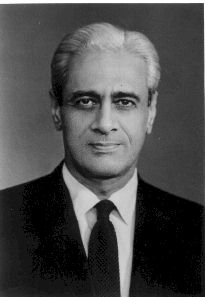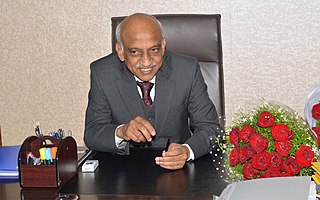
The NAL Saras is the first Indian multi-purpose civilian aircraft in the light transport aircraft category as designed by the National Aerospace Laboratories (NAL).

The National Aerospace Laboratories (NAL) is India's first and largest aerospace research company established by the Council of Scientific and Industrial Research (CSIR) in Delhi in 1959. The company closely operates with HAL, DRDO, and ISRO and has the primary responsibility of developing civilian aircraft in India. It concentrates on research in advanced topics in aerospace and related disciplines.

Satish Dhawan was an Indian mathematician and aerospace engineer, widely regarded as the father of experimental fluid dynamics research in India. Born in Srinagar, Dhawan was educated in India and further on in United States. Dhawan was one of the most eminent researchers in the field of turbulence and boundary layers, leading the successful and indigenous development of the Indian space programme. He succeeded M. G. K. Menon, as the third chairman of the Indian Space Research Organisation (ISRO) in 1972. The second launch pad of ISRO, Satish Dhawan space centre is named after him. He is greatly regarded as the man behind A. P. J. Abdul Kalam
Baldev Raj was an Indian scientist and director of the Indira Gandhi Centre for Atomic Research (IGCAR) in Kalpakkam, India.

Roddam Narasimha FRS was an Indian aerospace scientist and fluid dynamicist. He was a professor of Aerospace Engineering at the Indian Institute of Science (1962–1999), director of the National Aerospace Laboratories (1984–1993) and the chairman of the Engineering Mechanics Unit at Jawaharlal Nehru Centre for Advanced Scientific Research. He was the DST Year-of-Science Chair Professor at JNCASR and concurrently held the Pratt & Whitney Chair in Science and Engineering at the University of Hyderabad. Narasimha was awarded the Padma Vibhushan, India's second-highest civilian award, in 2013. for his contributions to advance India's aerospace technology.

Kota Harinarayana is an aviation engineer. He was born in Brahmapur. He was appointed as chairman of the board of governors of IIT (BHU), Varanasi by Hon'ble President of India on 25 August 2020 for three years. He was the vice-chancellor of the University of Hyderabad and the president of the Aeronautical Society of India.
Parivakkam Subramaniam Veeraraghavan is a well known space scientist and rocket technologist of India. He has served as the Director of Vikram Sarabhai Space Centre (VSSC), Thiruvananthapuram, Kerala and as the Director of ISRO Inertial Systems Unit (IISU), Thiruvananthapuram. One of the most senior scientists at Indian Space Research Organization (ISRO), Veeraraghavan is known for his contributions to launch vehicle technology, especially in the areas of integration & checkout and Inertial Systems of ISROs launch vehicles. Presently, he is holding the honorary position of Prof. Vikram Sarabhai Distinguished Professor in VSSC, ISRO since January 2013.
Sitaram Rao Valluri was an engineer and scientist noted for his work in metal fatigue. He completed his doctorate in 1954 at Caltech with a dissertation under Ernest Sechler and stayed thereafter to continue his research work. In 1963, he won the Wright Brothers Medal with George Bockrath and James Glassco for a paper on the relationship between crack propagation and fatigue in metals. He later returned to India and joined the Applied Mechanics Department of Indian Institute of Technology, Madras where he distinguished himself as a teacher, an outstanding researcher and a pre-eminent authority in the field of metal fatigue. He was invited to take over as the Director of National Aeronautical laboratory in Bangalore, later renamed as CSIR- National Aerospace Laboratories to succeed the first director Dr.P. Nilakantan. During his tenure for 19 years, he transformed NAL into a vibrant force in Indian Aeronautics. He was also instrumental in framing the new recruitment and assessment scheme of CSIR, popularly known as Valluri /Varadarajan Committee which recommended a new policy of recruitment and assessment in the CSIR laboratories in the year 1981. This was widely acknowledged as one of the most significant steps which led to the arrest of attrition of bright scientific personnel from advanced scientific institutions in India. He played a major role in the conception of the light combat aircraft (LCA) program in 1980s and briefly served as the first Director General of the Aeronautical Development Agency, Bangalore, the nodal agency for the design and development of LCA in 1985.
Brahm Prakash, was a metallurgist known for his work with nuclear materials in India.

Professor Bhagavatula Dattaguru is an Indian engineer and academic. He has received several awards, including the Padma Shri Award, India's fourth highest civilian honour in 2005 in the field of science and engineering.

Aluru Seelin Kiran Kumar is an Indian space scientist and former chairman of the Indian Space Research Organisation, having assumed office on 14 January 2015. He is credited with the development of key scientific instruments aboard the Chandrayaan-1 and Mangalyaan space crafts. In 2014, he was awarded the Padma Shri, India's fourth highest civilian award, for his contributions to the fields of science and technology. Kiran Kumar previously served as Director of Ahmedabad Space Applications Centre.

Prem Shanker Goel is an Indian space scientist, former secretary at the Department of Ocean Development, Ministry of Earth Sciences, Government of India and a former director of Indian Space Research Organization. He was honored by the Government of India, in 2001, with the fourth highest Indian civilian award of Padma Shri.

Narayanaswamy Balakrishnan is an Indian aerospace and computer scientist. He is a Professor of the Department of Aerospace Engineering and Supercomputer Education Research Centre of Indian Institute of Science and a visiting professor of Jawaharlal Nehru Centre for Advanced Scientific Research. Balakrishnan was honored by the Government of India, in 2002, with the fourth highest Indian civilian award of Padma Shri

Prahlada Rama Rao is an Indian missile scientist, former vice chancellor of Defence Institute of Advanced Technology and a former director of Defence Research and Development Laboratory, the largest of the Defence Research and Development Organization laboratories in India, known for his contributions to Indian space programme. He was honoured by the Government of India in 2015 with Padma Shri, the fourth highest Indian civilian award.
N. Prabhakar is an Indian scientist and the Chief Controller, System Analysis and Modelling Centre (SAM-C) of the Defence Research and Development Organization (DRDO). He graduated in Electrical and Electronics Engineering (BE) from Annamalai University and enrolled at the Indian Institute of Science, Bengaluru from where he obtained his master's degree (ME). He pursued his research at Shanmugha Arts, Science, Technology & Research Academy, secured a doctoral degree in Air Defence Systems and joined the Defence Research and Development Laboratory (DRDL) in 1980.

Vishnu Madav Ghatage (1908–1991) was an Indian aeronautical engineer, known for his pioneering conceptual and engineering contributions to Indian aeronautics. He led the team which designed and developed HAL HT-2, the first Indian designed and built aircraft. He was honoured by the Government of India in 1965, with the award of Padma Shri, the fourth highest Indian civilian award for his services to the nation.
Vakkaleri Narayana Rao was an Indian defence scientist and one of the pioneers of Electronic Warfare in India. He was a former director of the Defence Electronics Research Laboratory, Hyderabad. The Government of India awarded him the fourth highest Indian civilian honour of Padma Shri in 1982.
Suryanarayanan Srinivasan (1941–1999) was an Indian aeronautical engineer and the Director of the Vikram Sarabhai Space Centre (VSSC), known for his pioneering work in rocket science. He also served as the director of Satish Dhawan Space Centre and assisted A. P. J. Abdul Kalam in the SLV3 Mission as its deputy director. He was an elected Fellow of the Aeronautical Society of India and the Indian National Academy of Engineering. The Government of India awarded him the third highest civilian honour of the Padma Bhushan, in 2000, for his contributions to Indian space program.
Dipankar Banerjee is an Indian physical metallurgist, materials engineer and a former chief controller of R&D at the Defence Research and Development Organization (DRDO). Known for his studies on titanium alloys, Banerjee is an elected fellow of all the three major Indian science academies namely Indian Academy of Sciences, Indian National Science Academy and National Academy of Sciences, India as well as the Indian National Academy of Engineering. The Council of Scientific and Industrial Research, the apex agency of the Government of India for scientific research, awarded him the Shanti Swarup Bhatnagar Prize for Science and Technology, one of the highest Indian science awards for his contributions to Engineering Sciences in 1993. He received the fourth highest Indian civilian honour of Padma Shri from the Government of India in 2005.

S. Unnikrishnan Nair is an Indian aerospace engineer presently serving as the director of Vikram Sarabhai Space Centre (VSSC). He is known for his works in the field of launch vehicle design, Space Capsule Recovery Experiment (SRE), and Human Spaceflight Programme. Prior to his directorship of VSSC, he was Director of Human Space Flight Centre, Bengaluru. He is also currently holding the additional charge of the Director, Indian Institute of Space Science and Technology.












